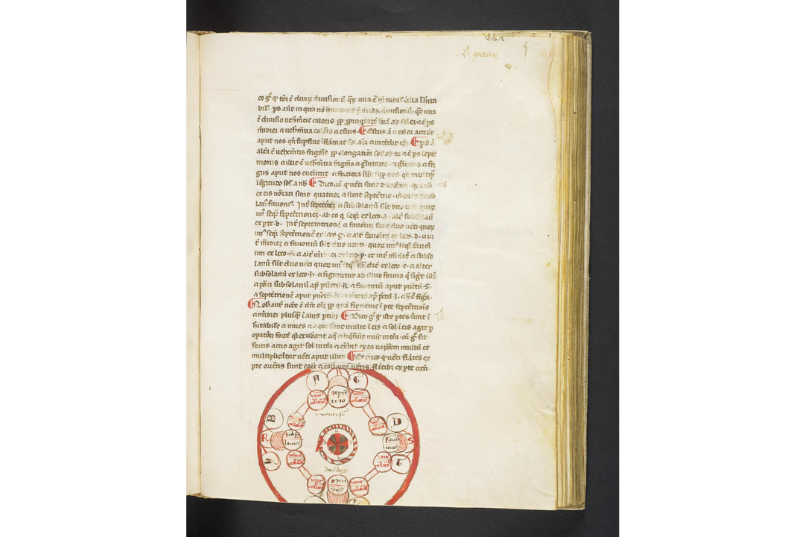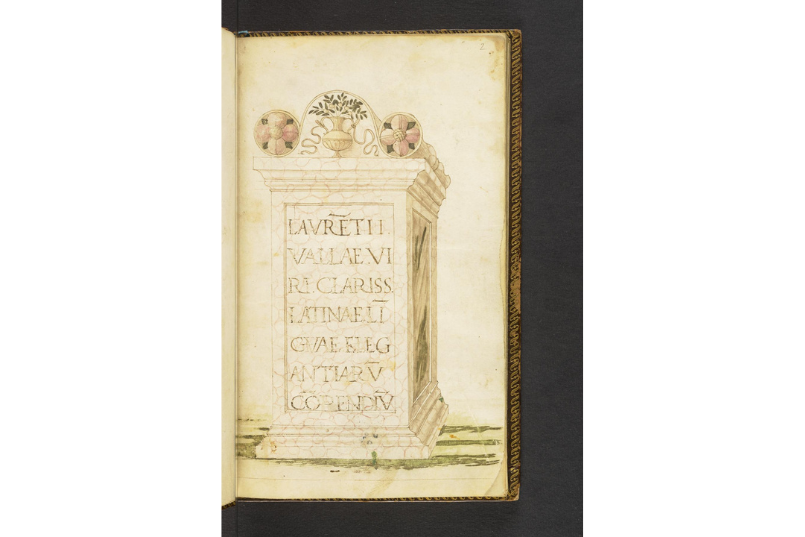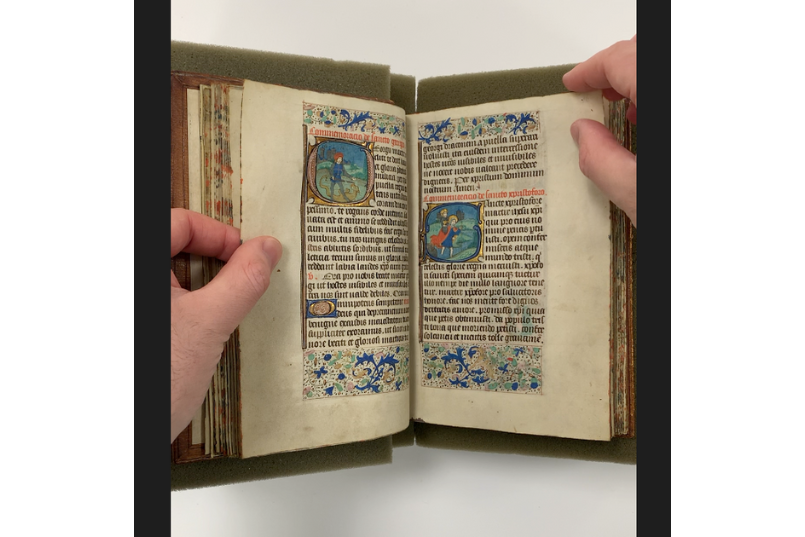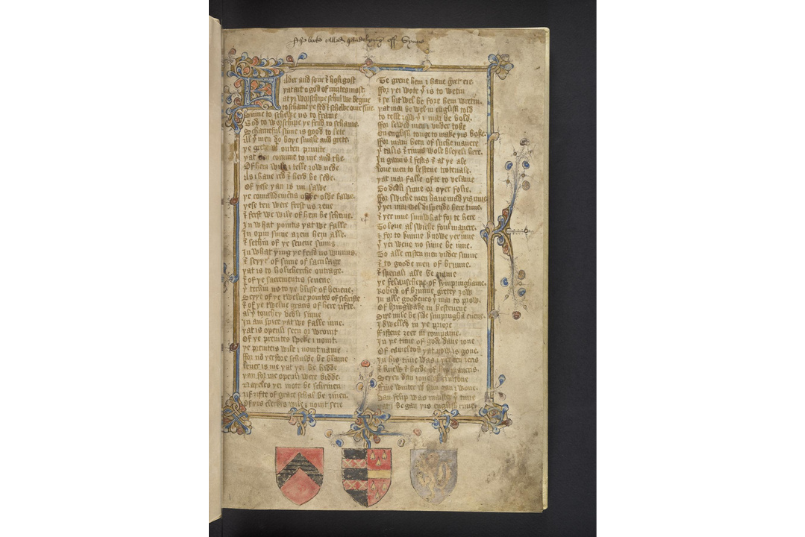Manuscripts from the Folger Shakespeare Library Visit Penn

During an ongoing renovation at the Folger Shakespeare Library from late 2021 to 2023, a selection of 29 of the library’s pre-modern manuscripts are being cared for by the University of Pennsylvania Libraries’ Kislak Center for Special Collections, Rare Books, and Manuscripts. This exciting partnership allows for these rare items, produced in England and in continental Europe between the 13th and 16th centuries, to remain available to researchers during the Folger’s extended closure. The initiative also leverages the scholarly expertise of Penn’s Schoenberg Institute for Manuscript Studies (SIMS) and the digitization capabilities of the Schoenberg Center for Electronic Text and Image (SCETI) in order to add the manuscripts to OPenn, the Penn Libraries’ open access repository for primary digital resources.
During the 2021–2022 academic year, these items were given enhanced metadata by staff at SIMS, were digitized by SCETI, and were added to OPenn. For the duration of the 2022–2023 academic year, individuals from the Penn and Folger communities, as well as those who do not currently have affiliations with either institution, will be able to consult the manuscripts directly by visiting the Kislak Center’s MacDonald Reading Room. The visiting manuscripts will also be integrated into classes held on the sixth floor of Van Pelt-Dietrich Library Center on Penn’s campus.
The links between the Penn Libraries and the Folger run deep. Penn’s Furness Memorial Library, although modest in comparison to the extraordinary holdings of the Folger, ranks among the strongest university collections of Shakespeariana in North America. It was established by Penn professor and trustee Horace Howard Furness. A generation older than Henry Clay Folger, Furness was the academic advisor of Folger’s wife, Emily Jordan Folger, who, during her husband’s lifetime and after, proved instrumental in the formation of the Folger Shakespeare Library and its building in Washington, D.C. Though their collection of books and manuscripts related to the Bard would grow to outstrip any other, the Folgers admired Furness’ pioneering efforts at establishing Shakespeare studies as part of the university curriculum. They also drew inspiration from his important work as an editor of new editions of the plays.
The selection of pre-modern manuscripts on loan to Penn consists of a part of the Folger’s holdings that predate Shakespeare’s lifetime. Most of the items were acquired by Henry Clay Folger in 1924 from the estate of the English bibliophile William Thomas Smedley (1858–1920). They form part of a larger collection of some 1,460 volumes hailing from Smedley’s library, which includes hundreds of incunabula and 16th-century imprints. These items complement other parts of the Folger’s collections by illustrating Shakespeare’s broader intellectual and historical background.
The items on loan represent a broad range of topics. As a group, they complement and fill gaps in the manuscript holdings of the Penn Libraries, notably the Lawrence J. Schoenberg Collection, which traces the journey of practical and empirical knowledge from antiquity through to the Renaissance, often by means of Arabic-language intermediaries. The renewal of Aristotelean thought during the later Middle Ages is exemplified by the Folger’s fine copy of the Physica dated to around 1300—only about a century after its translation into Latin. In this instance, it is accompanied by various pseudo-Aristotelean treatises and a translation of Avicenna’s work on geology (V.b.32).

A cluster of works represent the humanist revival of interest in classical rhetoric, especially the didactic works of Marcus Tullius Cicero, in the 15th century: a copy of the Rhetorica ad Herennium probably copied in Italy for Gundisalvus de Bivero, bishop of Salamanca (V.a.106); a miscellany of treatises and pseudonymous orations (V.a.112); and a selection of shorter works by the author alongside his translation of Plato’s Timaeus (V.a.88). A beautiful exemplar of a classically inspired “modern” text on Latin grammar, Agostino Dati’s Elegantiolae (here falsely attributed to the great rhetorician Lorenzo Valla) is introduced by an imposing pen-and-ink stele with the name of the presumed author of the text inscribed in Roman capitals (V.a.102).

The manuscripts from the Folger also include texts of practical importance to people of the era. The common law legal tradition is represented by a 14th-century book of statutes (V.a.256), while canon law is illustrated through an imposing commentary on the Decretals of Pope Gregory IX (V.b.42). The origins of encyclopedism are covered by portion of a 13th-century copy of Isidore of Seville’s Etymologies (V.b.31), which can be compared to a roughly contemporary copy at Penn (LJS 184). There are also devotional works, exemplified by a Book of Hours for the use of Sarum, produced in the low countries for the English market and profusely illustrated with historiated initials (V.a.228). Unlike many other books of hours used in England, it has not had its prayer to Thomas Beckett crossed out or erased, in defiance of the order given in 1538 by Henry VIII to obliterate images and texts associated with this potent symbol of resistance to the monarchy.

Uniquely, several more items from the Folger were authored or produced in Britain or were owned by English collectors early in their lifetimes, making them invaluable resources for Penn’s growing community of English department faculty and students with an interest in the “Medieval-Renaissance” era. A workaday 15th-century manuscript, in addition to containing a treatise on the art of rhetoric, remarkably includes Ceolfrith of Wearmouth’s letter on the computation of Easter addressed to King Nechtan, excerpted from Bede the Venerable’s early-eighth-century Ecclesiastical History (V.a.167). Three important works of the Middle English literary canon are represented: John Gower’s Confessio Amantis, in a later 15th-century copy on parchment (V.b.29); a recension of the popular Chronicle of England, known as The Brut on account of its retelling of the legendary foundation of England by Brutus, son of Aeneas V.b.106); and an imposing and rare copy of Robert Mannyng’s Handlyng Synne (V.b.236). While another copy of Gower’s work exists locally at the Rosenbach Library (MS 1083/29), and a Brut Chronicle is held at the Free Library of Philadelphia (Lewis E 238), and both have been digitized as part of the BiblioPhilly project, these signal texts are not otherwise present in manuscript form at Penn.

Researchers can consult the Folger manuscripts on site in the Kislak Center’s MacDonald Reading Room by appointment. Researchers will be required to have registered both as Kislak Center Special Collections researchers and as Folger Shakespeare Library patrons. Find out how to register, learn more about visiting the reading room, and view the full list of manuscripts.
Anyone in the world can view and download the digitized manuscripts in OPenn. No login or institutional affiliation is required.
Over the next year, the Folger and the Penn Libraries will also be offering exciting glimpses and fascinating commentary about these manuscripts through their social media channels. Follow along at the Libraries and at the Folger.
Banner Image: W.T. Smedley bookplate from Phaedrum ... etc. manuscript, ca. 1460.. Folger Shakespeare Library, Washington, D.C. V.a.107, recto of first front flyleaf.
Date
September 8, 2022
